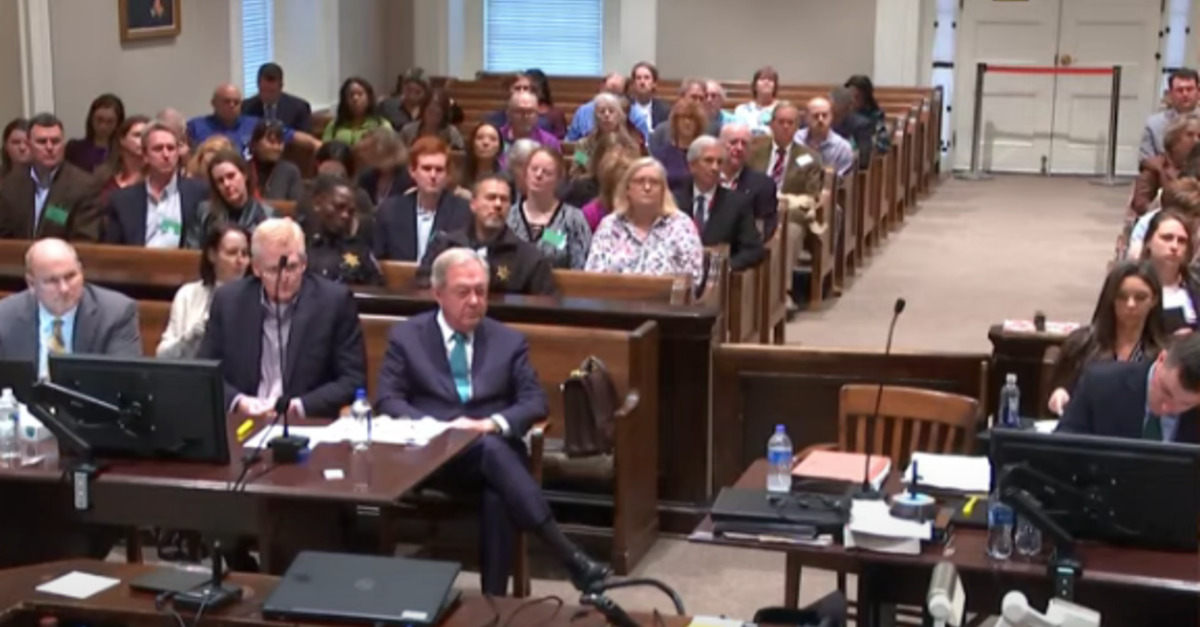Opening arguments began late Wednesday afternoon in the double murder trial of disgraced South Carolina attorney Alex Murdaugh.
“Listen to that gathering storm that all came to a head on June 7, 2021,” lead prosecutor Creighton Waters said. “Alex murdered Maggie and Paul. He was the storm. The storm was coming for them.”
The 54-year-old disbarred lawyer stands accused of shooting and killing his wife, Margaret “Maggie” Murdaugh, 52, and their youngest son Paul Murdaugh, 22, near dog kennels on the family’s 1,770-acre hunting lodge, sometime between 8:30 p.m. and 10:06 p.m. on June 7, 2021.
‘Pow. Pow’
The rule in Judge Clifton Newman‘s court is that jurors are seated first. That happened just before 3:30 p.m. EST. The media and the public were then ushered in and the state began its case-in-chief by recounting their timeline of Paul and Maggie Murdaugh’s demise.
“His son Paul Murdaugh was standing in a small feed room with some kennels they had on the property,” Waters said. “About 8:50 p.m., the defendant over there, Alex Murdaugh, took a 12-gauge shotgun and shot him in the shoulder, in the chest and the shoulder, with buckshot.”
A second shot, he said was fired, “under” Paul Murdaugh’s head that did “catastrophic damage to his brain and to his head.”
“Just moments later, he picked up a 300 Blackout – which is a type of ammunition – but an AR-style rifle,” Waters added. “And opened fire on his wife, Maggie, just feet away near some sheds that used to be a hangar. Pow. Pow. Two shots: abdomen and the leg. And took her down.”
After that, the prosecutor said, Alex Murdaugh continued to fire the weapon, including an additional two shots to his wife’s head that “again, did catastrophic damage and killed her instantly.”
The state believes the murders happened more or less instantaneously and without even a moment for the victims to react. “They were shot at close range and they did not have defensive wounds,” Waters said of the defendant’s dead wife and son.
Previewing the state’s evidence, the prosecutor repeatedly mentioned that cellular phone records would prove “crucial” in the case due to alleged statements the defendant made about his location in relation to the family’s dog kennels on the night in question. “He told anyone who would listen that he was never at those kennels,” Waters said. “The cell phones are going to show otherwise.”
‘He didn’t do it’

Alex Murdaugh sits with his attorneys before opening arguments in his Colleton County murder trial on Jan. 25, 2023.
The defense accepted, conditionally, some of what the cellphone evidence would show but said those “records are incomplete” and “not necessarily accurate to the extent they’re being relied on” by the state. Murdaugh’s defense attorney Dick Harpootlian did not take issue with the timeline provided by Waters showing when Alex Murdaugh left Moselle to visit his ailing mother and when he returned home a little less than an hour later.
Instead, the defense said, the prosecution’s timeline – based on those cellphone records – simply doesn’t make sense.
Based on the state’s own understanding of the evidence, Maggie Murdaugh’s cellphone was last used around 8:54 p.m. on the night of the slayings while Alex Murdaugh’s cellphone placed him in his car at around 9:06 p.m. as he prepared to visit his mother.
“Where are the bloody clothes?” Harpootlian asked out loud twice, saying the state’s version of events would have left Alex Murdaugh less than 10 minutes to “execute” both victims, travel several hundred yards, remove and dispose of blood-covered clothes that have never been found, and then get in the car and drive away.
Blood that made it onto Alex Murdaugh’s white T-shirt the night of the murders has become an issue of marked dispute among the prosecution and the defense. The South Carolina Attorney General’s Office and Palmetto State investigators have amassed expert witnesses to testify that some of that blood was the result of blood spatter from the shotgun thought to have killed Paul Murdaugh. Harpootlian and defense co-counsel Jim Griffin have filed numerous pre-trial motions to prevent blood spatter testimony from ever reaching jurors’ ears.
“What you’ve heard from the attorney general as facts are not – are not,” Harpootlian told jurors Wednesday. “They’re his theories. They’re conjecture.”
Harpootlian ended by reminding jurors of their role as deciders of fact, saying the defense did not have to prove anything – and to excuse any offensive, irritating, or anger-inducing behavior by holding it against him instead of his client.
“Remember, as you sit there right now, in your mind: He didn’t do it,” the defense attorney insisted, pointing to his client. “He is innocent. He would require a verdict of ‘not guilty’ from you. That’s the law. That’s your oath.”
A few minutes after 4:30 p.m., the state and defense agreed to postpone the first witness due to technical issues with body-worn camera footage and the length of those exhibits. By 4:50 p.m., jurors were then dismissed until 9:30 a.m. Thursday morning.
After the defense exhausted six strikes, and the state used three of their own, the 12-person jury of eight women and four men – as well as six alternates – were impaneled in Colleton County on Wednesday morning. Ten of the jurors are white; two are Black; all in their thirties through their sixties. Among the six alternates: four are men; two are women; split equally between Black and white; and in their twenties through their forties.